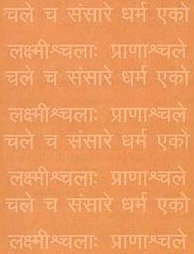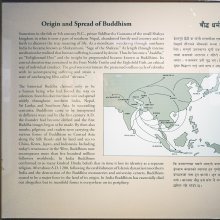Upadesha, Upadeśa, Upadesa: 35 definitions
Introduction:
Upadesha means something in Buddhism, Pali, Hinduism, Sanskrit, Jainism, Prakrit, Marathi, Hindi. If you want to know the exact meaning, history, etymology or English translation of this term then check out the descriptions on this page. Add your comment or reference to a book if you want to contribute to this summary article.
The Sanskrit term Upadeśa can be transliterated into English as Upadesa or Upadesha, using the IAST transliteration scheme (?).
Alternative spellings of this word include Updesh.
Images (photo gallery)
In Hinduism
Purana and Itihasa (epic history)
Source: archive.org: Shiva Purana - English TranslationUpadeśa (उपदेश) refers to “education”, according to the Śivapurāṇa 2.3.7.—Accordingly, after the Goddess (Umā/Śivā) incarnated as Pārvatī by becoming the daughter of Menā:—“[...] O sage, the goddess Śivā when the suitable time for her education arrived [i.e., upadeśa-samaya] learnt all the lores from a good preceptor, with concentrated mind and great pleasure. Just as the flock of swans returns to the Gaṅgā in the autumnal season and just as the brilliant lustre manifests itself in the medicinal herbs during the night, so also all the learning of the previous birth returned to Kālī. O sage, thus I have described one of the divine sports of Śivā. I shall narrate another one of her divine sports. You listen to it lovingly”.
Source: Cologne Digital Sanskrit Dictionaries: The Purana IndexUpadeśa (उपदेश).—One of the ten lakṣaṇas of the Brāhmaṇas.*
- * Vāyu-purāṇa 59. 139.

The Purana (पुराण, purāṇas) refers to Sanskrit literature preserving ancient India’s vast cultural history, including historical legends, religious ceremonies, various arts and sciences. The eighteen mahapuranas total over 400,000 shlokas (metrical couplets) and date to at least several centuries BCE.
Arthashastra (politics and welfare)
Source: Wisdom Library: ArthaśāstraUpadeśa (उपदेश) refers to “guidance” and is the name of a yukti, or ‘technical division’, according to which the contents of the Arthaśāstra by Cāṇakya are grouped. Cāṇakya (4th-century BCE), aka Kauṭilya, was the chief minister of Chandragupta Maurya, the founder of the famous Maurya Empire.

Arthashastra (अर्थशास्त्र, arthaśāstra) literature concerns itself with the teachings (shastra) of economic prosperity (artha) statecraft, politics and military tactics. The term arthashastra refers to both the name of these scientific teachings, as well as the name of a Sanskrit work included in such literature. This book was written (3rd century BCE) by by Kautilya, who flourished in the 4th century BCE.
Natyashastra (theatrics and dramaturgy)
Source: Wisdom Library: Nāṭya-śāstraUpadeśa (उपदेश, “instruction”) refers to one of the twelve froms of verbal representation (vācika), according to the Nāṭyaśāstra chapter 24. These verbal representations are to be expressed using the various representations of the body (śārira). Vācika forms a part of abhinaya (techniques of representation) which is used in communicating the meaning of the drama (nāṭya) and calling forth the sentiment (rasa).
According to the Nāṭyaśāastra, “to say ‘do this’ or ‘take this’ is an example of instruction (upadeśa)”.

Natyashastra (नाट्यशास्त्र, nāṭyaśāstra) refers to both the ancient Indian tradition (shastra) of performing arts, (natya—theatrics, drama, dance, music), as well as the name of a Sanskrit work dealing with these subjects. It also teaches the rules for composing Dramatic plays (nataka), construction and performance of Theater, and Poetic works (kavya).
Vyakarana (Sanskrit grammar)
Source: Wikisource: A dictionary of Sanskrit grammarUpadeśa (उपदेश).—Instruction; original enunciation; first or original precepts or teaching; cf. उपदेश आद्योच्चारणम् (upadeśa ādyoccāraṇam) S. K. on T the rule उपदेशेजनुनासिक इत् (upadeśejanunāsika it) P.I.3.2. cf. वर्णानामुपदेशः कर्तव्यः (varṇānāmupadeśaḥ kartavyaḥ); M. Bh. on Āhn. I. Vārt. 15. For difference between उपदेश (upadeśa) and उद्देश (uddeśa) see उद्देश (uddeśa); cf. also उपदिश्यतेनेनेत्युपदेशः । शास्त्र-वाक्यानि, सूत्रपाठः खिलपाठश्च (upadiśyatenenetyupadeśaḥ | śāstra-vākyāni, sūtrapāṭhaḥ khilapāṭhaśca) Kāśikā on P. I.3.2; cf. also Vyāḍi. Pari. 5; (2) employment (of a word) for others cf. उपेदशः परार्थः प्रयोगः । स्वयमेव तु बुद्धया यदा प्ररमृशति तदा नास्त्युपदेशः (upedaśaḥ parārthaḥ prayogaḥ | svayameva tu buddhayā yadā praramṛśati tadā nāstyupadeśaḥ) Kāś. on अदोनुपदेशे (adonupadeśe) P.I.4.70.

Vyakarana (व्याकरण, vyākaraṇa) refers to Sanskrit grammar and represents one of the six additional sciences (vedanga) to be studied along with the Vedas. Vyakarana concerns itself with the rules of Sanskrit grammar and linguistic analysis in order to establish the correct context of words and sentences.
Ayurveda (science of life)
Source: gurumukhi.ru: Ayurveda glossary of termsUpadeśa (उपदेश):—[upadeśaḥ] Authoritative instructions; statements of enlightened persons which are in the form of advice or injunction

Āyurveda (आयुर्वेद, ayurveda) is a branch of Indian science dealing with medicine, herbalism, taxology, anatomy, surgery, alchemy and related topics. Traditional practice of Āyurveda in ancient India dates back to at least the first millenium BC. Literature is commonly written in Sanskrit using various poetic metres.
Jyotisha (astronomy and astrology)
Source: Wisdom Library: Brihat Samhita by VarahamihiraUpadeśa (उपदेश) refers to “direction” [=“instruction”?], according to the Bṛhatsaṃhitā (chapter 12), an encyclopedic Sanskrit work written by Varāhamihira mainly focusing on the science of ancient Indian astronomy astronomy (Jyotiṣa).—Accordingly, “I shall now expound about the movements of the Seven Ṛṣis (Saptarṣi), through whom the northern region shines as though bedecked with a pearl necklace, like a maiden with a smiling countenance wearing a garland of white lotuses. Or by the direction of her lord—the Pole-Star (Seven Ṛṣis) [i.e., dhruva-nāyaka-upadeśa], the northern maiden (quarter) appears to dance round as the Seven Ṛṣis move in their course. I begin to treat of these stars adopting the views of Vṛddha Garga”.

Jyotisha (ज्योतिष, jyotiṣa or jyotish) refers to ‘astronomy’ or “Vedic astrology” and represents the fifth of the six Vedangas (additional sciences to be studied along with the Vedas). Jyotisha concerns itself with the study and prediction of the movements of celestial bodies, in order to calculate the auspicious time for rituals and ceremonies.
Shaivism (Shaiva philosophy)
Source: Brill: Śaivism and the Tantric TraditionsUpadeśa (उपदेश) refers to “instruction”, according to the Īśvarapratyabhijñākārikā III.2.12.—Accordingly, “But when, through realizing [that the divine] qualities such as all-pervasiveness and eternality apply to oneself, by having the experience of the [real] “I” whose nature is [unqualified] freedom—[an experience] pointed out by the guru’s instruction (guru-upadeśa) and other methods that I have explained—[and] having therefore emerged as it were from [identification with] the objective knowables of the Void etc., and [as a result] abiding [in one’s real nature], then that is the [transcendent] state [called] the Fourth. [...]”.

Shaiva (शैव, śaiva) or Shaivism (śaivism) represents a tradition of Hinduism worshiping Shiva as the supreme being. Closely related to Shaktism, Shaiva literature includes a range of scriptures, including Tantras, while the root of this tradition may be traced back to the ancient Vedas.
Kavya (poetry)
Source: Brill: Śaivism and the Tantric Traditions (kavya)Upadeśa (उपदेश) refers to “(being) instructed (on a particular doctrine)”, according to Bāṇa’s Kādambarī (p. 226).—There are apparently several Tantric rites that Bāṇa pejoratively associates with the priest: [...] “he had written down the [work known as ] the ‘Doctrine of Mahākāla’ instructed (upadeśa) to him by a withered Mahāpāśupata mendicant”; “he was one in whom the disease of talking about [finding] treasure had arisen”; “in him the wind [disease] of alchemy had grown”; “he entertained the deluded desire of becoming the lover of a Yakṣa maiden”.

Kavya (काव्य, kavya) refers to Sanskrit poetry, a popular ancient Indian tradition of literature. There have been many Sanskrit poets over the ages, hailing from ancient India and beyond. This topic includes mahakavya, or ‘epic poetry’ and natya, or ‘dramatic poetry’.
Nyaya (school of philosophy)
Source: Google Books: Identity, difference and alterity in the philosophy of the Pratyabhijñā (Nyāya)Upadeśa (उपदेश) refers to the “teaching (of a trustworthy person)” according to Vātsyāyana in his Nyāyasūtrabhāṣya (I, 1, 10, p. 16).—Accordingly, “Of the [listed objects of knowledge], the Self, on the other hand, is not grasped by direct perception (pratyakṣa). Is it known only through the teaching of a trustworthy person (āpta-upadeśa)? We answer: no. It can also be known by inference (anumāna)”.

Nyaya (न्याय, nyaya) refers to a school of Hindu philosophy (astika), drawing its subject-matter from the Upanishads. The Nyaya philosophy is known for its theories on logic, methodology and epistemology, however, it is closely related with Vaisheshika in terms of metaphysics.
Yoga (school of philosophy)
Source: ORA: Amanaska (king of all yogas): A Critical Edition and Annotated Translation by Jason BirchUpadeśa (उपदेश) refers to the “(true) teaching”, according to the Amanaska Yoga treatise dealing with meditation, absorption, yogic powers and liberation.—Accordingly, as Īśvara says to Vāmadeva: “[...] Some who are full of pride because they know a multitude of scriptures, do not know the [true] teaching (upadeśa), not even by [studying] hundreds of texts. [Because their minds] are agitated by hundreds of conceptual processes consisting of meditation and so forth, [all of which are] grounded in desire [for some particular reward], they do not find the desired state that is to be obtained, however hard they torture [themselves]. [...]”.

Yoga is originally considered a branch of Hindu philosophy (astika), but both ancient and modern Yoga combine the physical, mental and spiritual. Yoga teaches various physical techniques also known as āsanas (postures), used for various purposes (eg., meditation, contemplation, relaxation).
Pancaratra (worship of Nārāyaṇa)
Source: archive.org: Catalogue of Pancaratra Agama TextsUpadeśa (उपदेश) refers to the “secret teaching” (imparted by Nārāyaṇa to Brahmā), as is discussed in the fourth chapter of the Agastyasaṃhitā (agastya-suīkṣṇa-saṃvāda edition), an ancient Pāñcarātra Āgama text dealing with the worship of Rāma, Sītā, Lakṣmaṇa and Hanumān.—Description of the chapter [mantraprāpti-prakāra]: “[...] Nārāyaṇa also instructed Hiraṇyagarbha to share the liberating knowledge with the other sages by instructing them also in the six-syllable mantra, the other mantras and yantras, that they too might be liberated. The instruction was this: just as any mantra has its receiving ṛṣi, its devatā to whom it is directed, its meter [chandas], its power [śakti] and its esoteric scope [bīja], so this mantra of six syllables has as its ṛṣi Brahmā, as its devatā Rāma, as its meter Gāyatrī, as its power namaḥ and as its scope “a” ti “ya”. This is the best of al mantras. Further, if one offers all he has to Rāma, he will enjoy the things of this world as well as liberation in the next. Having thus given the boon to Brahmā, Nārāyaṇa disappeared, says Śiva, leaving with Brahmā orders to spread the secret teaching [upadeśa] to the world at large. Brahmā and his fellow sages undertook to obey Nārāyaṇa’s orders; this is how Brahmā came to be the preceptor of all mankind. Śiva concludes his story by advising Pārvatī to learn that same all important six-syllable mantra, etc., in order to gain her own liberation. [...]”.

Pancaratra (पाञ्चरात्र, pāñcarātra) represents a tradition of Hinduism where Narayana is revered and worshipped. Closeley related to Vaishnavism, the Pancaratra literature includes various Agamas and tantras incorporating many Vaishnava philosophies.
General definition (in Hinduism)
Source: Wisdom Library: Hinduismsanskit; lit: 'instruction' or 'advice'.
In Buddhism
Mahayana (major branch of Buddhism)
Source: Wisdom Library: Maha Prajnaparamita Sastra1) Upadeśa (उपदेश) refers to “knowledge regarding teachings”, having its roots in the four Vedas, according Mahāprajñāpāramitāśāstra (chapter IV). Accordingly, at the time of the Buddha, the knowledge regarding teachings (upadeśa) was commonly exchanged between Brahmins and cow-herders.
2) Upadeśa (उपदेश, “exegesis”) refers to one of the twelve members of Buddhist texts (dvādaśāṅga), according to a note attached to the Mahāprajñāpāramitāśāstra chapter 51.—The upadeśa (‘exegesis’) responds to questioners and explains the ‘why’; furthermore, it broadly explains the meanings (artha). Moreover, the following are also called upadeśa: a. the Commentaries given by the Buddha, b. the sūtras explained by Mahākātyāyana, c. the teachings given in accordance with the Dharma by worldly individuals (pṛthagjana) up to the period of the counterfeit Dharma.

Mahayana (महायान, mahāyāna) is a major branch of Buddhism focusing on the path of a Bodhisattva (spiritual aspirants/ enlightened beings). Extant literature is vast and primarely composed in the Sanskrit language. There are many sūtras of which some of the earliest are the various Prajñāpāramitā sūtras.
Tibetan Buddhism (Vajrayana or tantric Buddhism)
Source: Google Books: The Lamp for Integrating the Practices (Caryamelapakapradipa)Upadeśa (उपदेश) refers to “personal instruction”, in Tibetan: man ngag.—Cf. Āmnāya (“tradition”).
Source: Brill: Śaivism and the Tantric Traditions (tantric Buddhism)Upadeśa (उपदेश) refers to the “instruction” (of the teacher), according to the Nāmamantrārthāvalokinī by Vilāsavajra, which is a commentary on the Nāmasaṃgīti.—Accordingly, [while commenting on verse 93cd]—“{With five faces. With five crests [of hair]. With a crown of five hair-braids}.—And this second half [of the verse] should be understood with reference to the Ādibuddha, via the teacher’s instruction (guru-upadeśa—gurūpadeśenādiyoge) on the beginning yoga (ādiyoga) [phase of the sādhana]. And as it is explained there, it is not restated here.”.

Tibetan Buddhism includes schools such as Nyingma, Kadampa, Kagyu and Gelug. Their primary canon of literature is divided in two broad categories: The Kangyur, which consists of Buddha’s words, and the Tengyur, which includes commentaries from various sources. Esotericism and tantra techniques (vajrayāna) are collected indepently.
General definition (in Buddhism)
Source: Wisdom Library: Dharma-samgrahaUpadeśa (उपदेश, “instruction”) refers to one of the “nine (types of) teachings” (sūtra) as defined in the Dharma-saṃgraha (section 62). The Dharma-samgraha (Dharmasangraha) is an extensive glossary of Buddhist technical terms in Sanskrit (e.g., upadeśa). The work is attributed to Nagarjuna who lived around the 2nd century A.D.
In Jainism
General definition (in Jainism)
Source: The University of Sydney: A study of the Twelve ReflectionsUpadeśa (उपदेश) refers to the “instruction (of a guru)”, according to the 11th century Jñānārṇava, a treatise on Jain Yoga in roughly 2200 Sanskrit verses composed by Śubhacandra.—Accordingly, “On account of the difference between what is intentional [com.—is because of wandering (paribhramataḥ) in the cycle of rebirth (saṃsāre) in accordance with the instruction of a guru, etc. (gurūpadeśādinā)] and unintentional [com.—is because of wandering (bhramataḥ) in the cycle of rebirth (saṃsāre) without (vinā) virtue (dharma)] , wearing away karma has two varieties which are the cause for cutting off the many chains produced by actions. Just as fruits of a tree ripen of their own accord and from [different] means so in this world [the ripening] of karmas is to be understood as [being] of its own accord in the form of [different] means”.

Jainism is an Indian religion of Dharma whose doctrine revolves around harmlessness (ahimsa) towards every living being. The two major branches (Digambara and Svetambara) of Jainism stimulate self-control (or, shramana, ‘self-reliance’) and spiritual development through a path of peace for the soul to progess to the ultimate goal.
Languages of India and abroad
Pali-English dictionary
Source: BuddhaSasana: Concise Pali-English Dictionaryupadesa : (m.) advice; indication; instruction.
Source: Sutta: The Pali Text Society's Pali-English DictionaryUpadesa, (fr. upadisati) pointing out, indication, instruction, advice PvA. 26 (tadupadesena read for tadupād°; KhA 208 differs at id. p.); KhA 100; Sdhp. 227. (Page 142)

Pali is the language of the Tipiṭaka, which is the sacred canon of Theravāda Buddhism and contains much of the Buddha’s speech. Closeley related to Sanskrit, both languages are used interchangeably between religions.
Marathi-English dictionary
Source: DDSA: The Molesworth Marathi and English Dictionaryupadēśa (उपदेश).—m (S) Instruction, teaching, communicating knowledge. 2 Advice, counsel, admonition. 3 Impartation of or initiation in a mantra.
Source: DDSA: The Aryabhusan school dictionary, Marathi-Englishupadēśa (उपदेश).—m Instruction. Advice, admoni- tion. Initiation in a mantra.
Marathi is an Indo-European language having over 70 million native speakers people in (predominantly) Maharashtra India. Marathi, like many other Indo-Aryan languages, evolved from early forms of Prakrit, which itself is a subset of Sanskrit, one of the most ancient languages of the world.
Sanskrit dictionary
Source: DDSA: The practical Sanskrit-English dictionaryUpadeśa (उपदेश).—
1) Instruction, teaching, advice, prescription; एष आदेशः, एष उपदेशः (eṣa ādeśaḥ, eṣa upadeśaḥ) Tait. Up.1.11.4. सुशिक्षितोऽपि सर्व उपदेशेन निपुणो भवति (suśikṣito'pi sarva upadeśena nipuṇo bhavati) M.1 (see the act inter alia); स्थिरोपदेशामुपदेशकाले प्रपेदिरे प्राक्तनजन्मविद्याः (sthiropadeśāmupadeśakāle prapedire prāktanajanmavidyāḥ) Kumārasambhava 1.3; अचिरप्रवृत्तोपदेशं नाट्यम् (acirapravṛttopadeśaṃ nāṭyam) M.1,2.1; Ś.2.3; Manusmṛti 8.272; Amaruśataka 29; R.12.57; K.26; M.6; परोपदेशे पाण्डित्यम् (paropadeśe pāṇḍityam) H.1.99.
2) Pointing out or referring to; शब्दानामितरे- तरोपदेशः (śabdānāmitare- taropadeśaḥ) Nir.
3) Specification, mentioning, naming.
4) A plea, pretext.
5) Initiation, communication of an initiatory Mantra or formula; चन्द्रसूर्यग्रहे तीर्थे सिद्धक्षेत्रे शिवालये । मन्त्रमात्रप्रकथनमुपदेशः स उच्यते (candrasūryagrahe tīrthe siddhakṣetre śivālaye | mantramātraprakathanamupadeśaḥ sa ucyate) ||
6) (In gram.) A form in a rule, an indicatory form (any word or part of a word, such as an affix, augment &c. with its anubandhas which show what particular grammatical rules are to be applied. उपदेश आद्योच्चारणम् (upadeśa ādyoccāraṇam) Sk.
Derivable forms: upadeśaḥ (उपदेशः).
Source: Cologne Digital Sanskrit Dictionaries: Edgerton Buddhist Hybrid Sanskrit DictionaryUpadeśa (उपदेश).—m., name of a type of Buddhist literature, one of the pravacana (last in both lists, ninth in Dharmasaṃgraha, twelfth in Mahāvyutpatti), lit. instruction: Dharmasaṃgraha 62; Mahāvyutpatti 1278. App. not so used in Pali.See Burnouf, Intr. 65 f.
Source: Cologne Digital Sanskrit Dictionaries: Shabda-Sagara Sanskrit-English DictionaryUpadeśa (उपदेश).—m.
(-śaḥ) 1. Advice, information, instruction. 2. Plea, pretext. 3. Specification. 4. Initiation, communication of the initiatory Mantra or fomula. 5. (In grammar,) An elementary term. E. upa before diś to shew, affix ghañ.
Source: Cologne Digital Sanskrit Dictionaries: Benfey Sanskrit-English DictionaryUpadeśa (उपदेश).—i. e. upa-diś + a, m. 1. Instruction, [Bhartṛhari, (ed. Bohlen.)] 2, 12. 2. Advice, [Rāmāyaṇa] 4, 40, 4. 3. A pretext, [Mānavadharmaśāstra] 9, 268.
Source: Cologne Digital Sanskrit Dictionaries: Cappeller Sanskrit-English DictionaryUpadeśa (उपदेश).—[masculine] hint, direction, advice, instruction; indicatory or conventional form ([grammar]).
Source: Cologne Digital Sanskrit Dictionaries: Monier-Williams Sanskrit-English Dictionary1) Upadeśa (उपदेश):—[=upa-deśa] [from upa-diś] a m. pointing out to, reference to, [Pāṇini 1-4, 70; Kapila; Bādarāyaṇa’s Brahma-sūtra; Jaimini] etc.
2) [v.s. ...] specification, instruction, teaching, information, advice, prescription, [Taittirīya-upaniṣad; Mahābhārata; Manu-smṛti; Suśruta; Śakuntalā; Hitopadeśa] etc.
3) [v.s. ...] plea, pretext (= apa-deśa), [Manu-smṛti ix, 268; Raghuvaṃśa; Kathāsaritsāgara]
4) [v.s. ...] initiation, communication of the initiatory Mantra or formula, [Kātyāyana-śrauta-sūtra]
5) [v.s. ...] (in [grammar]) original enunciation (id est. the original form [often having an Anubandha] in which a root, base, affix, augment, or any word or part of a word is enunciated in grammatical treatises), [Pāṇini; Kāśikā-vṛtti; Siddhānta-kaumudī] etc.
6) [v.s. ...] Name of a class of writings ([Buddhist literature])
7) [v.s. ...] a name, title, [Monier-Williams’ Sanskrit-English Dictionary]
8) [=upa-deśa] b etc. See upa-√diś.
Source: Cologne Digital Sanskrit Dictionaries: Yates Sanskrit-English DictionaryUpadeśa (उपदेश):—[upa-deśa] (śaḥ) 1. m. Instruction.
Source: DDSA: Paia-sadda-mahannavo; a comprehensive Prakrit Hindi dictionary (S)Upadeśa (उपदेश) in the Sanskrit language is related to the Prakrit word: Uvaesa.
[Sanskrit to German]
Sanskrit, also spelled संस्कृतम् (saṃskṛtam), is an ancient language of India commonly seen as the grandmother of the Indo-European language family (even English!). Closely allied with Prakrit and Pali, Sanskrit is more exhaustive in both grammar and terms and has the most extensive collection of literature in the world, greatly surpassing its sister-languages Greek and Latin.
Hindi dictionary
Source: DDSA: A practical Hindi-English dictionaryUpadeśa (उपदेश) [Also spelled updesh]:—(nm) precept, sermon; preaching, teaching; ~[vāda] didacticism; ~[vādī] didactician; didactic; [upadeśātmaka] didactic; hence [upadiṣṭa] (a).
...
Kannada-English dictionary
Source: Alar: Kannada-English corpusUpadēśa (ಉಪದೇಶ):—
1) [noun] teaching of fundamentals of some subject to; instruction.
2) [noun] opinion given as to what to do or how to handle a situation; counsel; advice.
3) [noun] initiation or communication of a mystic hymn or a formula.
--- OR ---
Upādēśa (ಉಪಾದೇಶ):—[noun] an instruction; an order; a behest.
Kannada is a Dravidian language (as opposed to the Indo-European language family) mainly spoken in the southwestern region of India.
Nepali dictionary
Source: unoes: Nepali-English DictionaryUpadeśa (उपदेश):—n. 1. advice; instruction; counsel; 2. moral teaching; preaching; sermon;
Nepali is the primary language of the Nepalese people counting almost 20 million native speakers. The country of Nepal is situated in the Himalaya mountain range to the north of India.
See also (Relevant definitions)
Partial matches: Desha, Upa, Teca.
Starts with (+21): Upadesha Sahasri, Upadeshacandrika, Upadeshacarya, Upadeshachattisi, Upadeshadikshavidhi, Upadeshadivishayavada, Upadeshagrantha, Upadeshaka, Upadeshakanda, Upadeshakarnika, Upadeshakarttri, Upadeshamala, Upadeshamgey, Upadeshamgudu, Upadeshamrita, Upadeshana, Upadeshanavant, Upadeshanavat, Upadeshanem, Upadeshanusarini.
Ends with (+14): Adesha-upadesha, Anupadesha, Aptopadesha, Ayurvedopadesha, Bhutopadesha, Brahmopadesha, Caturthasadbhavopadesha, Dharmopadesha, Dhatupadesha, Durupadesha, Ekashrutyupadesha, Gurupadesha, Hitopadesha, Kulopadesha, Kutopadesha, Mithyopadesha, Mrishopadesha, Mrityuvancanopadesha, Mrityuvanchanopadesha, Naradopadesha.
Full-text (+86): Hitopadesha, Upadeshata, Dharmopadesha, Upadeshasahasri, Upadeshin, Vyupadesha, Aupadeshika, Upadesharthavakya, Paropadesha, Yathopadesham, Upadesharasayana, Upadeshapancaka, Upadeshamala, Upadesharatnamala, Paramparyopadesha, Upadeshakarnika, Upadeshamrita, Nanopatecam, Tarmopatecam, Dvadashanga.
Relevant text
Search found 68 books and stories containing Upadesha, Upadeśa, Upadesa, Upadēśa, Upa-desha, Upa-deśa, Upa-desa, Upādēśa; (plurals include: Upadeshas, Upadeśas, Upadesas, Upadēśas, deshas, deśas, desas, Upādēśas). You can also click to the full overview containing English textual excerpts. Below are direct links for the most relevant articles:
Maha Prajnaparamita Sastra (by Gelongma Karma Migme Chödrön)
Part 2 - Hearing the twelve-membered speech of the Buddha < [Chapter LI - Seeing all the Buddha Fields]
Twelfth aṅga (member): Upadeśa (exegesis) < [Part 2 - Hearing the twelve-membered speech of the Buddha]
Introduction to fifth volume < [Introductions]
Satirical works of Kshemendra (study) (by Arpana Devi)
2. Summary of the Deśopadeśa < [Chapter 3 - Satirical Works of Kṣemendra]
4. Chandas or the metre < [Chapter 4 - Literary study of the Three Satirical Works]
Sahitya-kaumudi by Baladeva Vidyabhushana (by Gaurapada Dāsa)
Text 1.4 < [Chapter 1 - The Purpose of Poetry]
Text 10.120 [Yathā-saṅkhya] < [Chapter 10 - Ornaments of Meaning]
Text 7.145 < [Chapter 7 - Literary Faults]
Taittiriya Upanishad Bhashya Vartika (by R. Balasubramanian)
Verse 1.181 < [Book 1 - Śīkṣāvallī]
The Tattvasangraha [with commentary] (by Ganganatha Jha)
Verse 3226-3227 < [Chapter 26 - Examination of the ‘Person of Super-normal Vision’]
Sivaprakasam (Study in Bondage and Liberation) (by N. Veerappan)
Dasha Karya and Guru < [Chapter 7 - Liberation]
Main stages of liberation < [Chapter 7 - Liberation]

